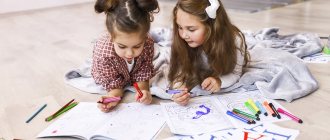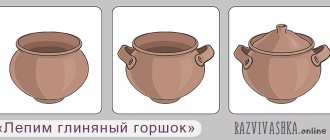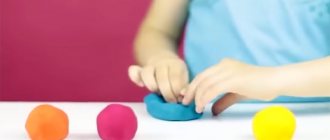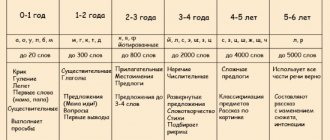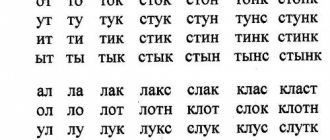- Does your baby absolutely not want to look at the letters in the alphabet?
- Is your child about to start first grade, but can he be forced to read only under pain of being “excommunicated” from the computer?
- Don’t know how to organize classes with a preschooler in such a way as to save your nerves and not completely discourage his interest in reading?
These and other problems in teaching preschoolers to read can be solved by organizing classes in a playful way.
For preschool children, play is the leading form of activity. Therefore, engaging with a preschooler by playing different games is the easiest and most effective way to teach him to read. Before we talk about what games are best to play with your child when learning to read, we will give some general tips on organizing classes.
- Exercise regularly! Let the classes be short (5-10 minutes), but daily. This is much more effective for preschoolers than 45-minute lessons once a week.
- Exercise everywhere. To learn to read, you don't necessarily have to sit your child at a table with books. You can learn letters in the park while taking a walk, drawing them with chalk on the asphalt or looking at signs, helping mom make cookies in the shape of letters, or studying license plates of cars in the parking lot, etc.
- Exercise when your child feels well: he has slept, is active and is ready for new games and activities.
- Constantly create situations of success for your child, praise him more often, focus his attention on what he has accomplished, and do not dwell on failures. Classes should be a joy for the child!
And one more thing you definitely need to know when starting to learn to read is in the article at the link.
What games can be played at different stages of teaching preschoolers to read?
Methods of teaching reading
Any discipline can include several teaching methods at once, and literacy teaching is no exception. When parents are just thinking about starting to teach their child to read, they may be confused by the variety of educational programs. The most popular of them include:
- Classical approach (sound method). This method is used in modern educational schools. First, the children study the sounds, then the letters corresponding to them. Later they get used to reading words letter by letter, syllable by syllable, and then completely.
- Zaitsev's cubes. This method involves studying literacy using special cubes, tables and audio materials, which were developed by the author of the program.
- Glen Doman's method. The program is based on working with special cards on which words are written. Adults reproduce them for the baby, and he gradually learns to read, bypassing the letter-by-letter stage.
- Maria Montessori's method. Classes are conducted using a large number of aids and materials. The technique is aimed at ensuring that students not only learn to recognize letters, but also remember how they are written.
When choosing a method for teaching children to read, parents should pay attention not only to its effectiveness, but also to how suitable it is for the preschooler. Each child is individual, and therefore some techniques may have a better impact on the development of his skills than others.
It is also worth remembering that each method has not only differences, but also similarities with other teaching programs. These include exercises, variations of which are used in almost all modern courses. Let's look at them in more detail.
We read words and sentences.
Learning to read words (and then sentences) presupposes that preschoolers are already actively working with books, but this does not mean that we stop playing in class. On the contrary, “dilute” learning with games as often as possible, switch from one type of activity to another so that the child gets less tired and learning goes more efficiently. Remember: it is not enough to teach a child to read, it is important to instill in him a love of reading. What games can be offered to parents of preschoolers at this stage of learning to read?
— Search for hidden words.
Lay out a trail of words in front of your child. Invite him to choose only “edible” words (or what is green / what is round in shape / only “live” words, etc.). If the track is long, you can take turns reading the words with your child.
— Traces with words.
Place cut out traces with words around the room (you can use ordinary sheets). Invite your child to walk from one end of the room to the other following these tracks: you can move further only by reading the word you are standing on. The child walks on them himself or with his favorite toy.
- Game "Airport" or "Parking".
In this game we train the attentiveness of preschoolers. Prepare several cards with very similar words so that the child does not guess the words, but carefully reads them to the end (for example, MOUTH, HORN, GROWTH, HORNS, ROSE, MOUTH, DEW). Place the cards around the room. These will be different airports/parking spaces. The child picks up an airplane (if you play airports) or a car (if you have a parking lot), after which you loudly and clearly call out exactly where he needs to land/park.
Exercises for learning to read
The ability to reproduce and perceive text requires a certain level of skill development. To successfully cope with this task, you need not only to know the alphabet, but also to have developed speech, good articulation, proper concentration, and so on. Some of the exercises for teaching children to read are aimed at training these abilities.
Regularly performing articulation and breathing exercises allows you to strengthen your speech apparatus and even out your breathing while playing text out loud. Thanks to these exercises, the baby will learn to read without stumbling, without swallowing the endings of words.
In addition to breathing and articulation, important aspects to note include training memory, concentration, imagination and reading comprehension. For these purposes, teachers use various educational games, each of which is aimed at training certain skills:
- "Continue the story." The student needs to familiarize himself with part of a text, and then come up with a continuation for it. This game promotes better comprehension of what you read, and also trains fantasy and imagination, without which it will be difficult to perceive the meaning of books in the future.
- “What kind of transport is coming?” The teacher plays an audio recording for the children, which records the sounds made by various types of transport: trucks, cars, motorcycles. Students must match the proposed sound with the vehicle to which it may belong. The game trains phonemic hearing and the ability to perceive and analyze sound information.
- "Word pairs". The teacher or parent reads to the child pairs of words selected at random, for example: car - cat, porridge - sky, toy - store. After some time, you need to read only the first words from these pairs to the baby. His task is to accurately name a pair for each listed word. This game trains memory and improves information processing skills.
These and many other games and exercises are often used both in group and individual lessons with preschoolers. But before you take on any tasks, you need to determine when and where to start teaching your child to read. What should parents know?
Sound method
The letter-subjunctive and syllabic methods of teaching reading were replaced in the 19th century by more progressive phonic teaching of literacy . The phrase “Sound method” means a system of teaching reading, which involves, at the first stage of learning, dividing words into their constituent letters and phonemes, and at the second stage of learning, involves the reverse action, that is, combining letters/phonemes into continuous syllables and words.
The main center of gravity of this system lies in the exercises of isolating individual sounds from words and then merging them into words, and both vowels and consonants are recognized separately as sounds. The study of sounds usually begins with some vowel, for example. y, to which some consonant is then added, for example. s, first in the so-called reverse syllable us (and it is prescribed to “draw out the first letter, and then, without dropping it, without stopping, add the second to it”), and then in the forward syllable su.
Example: At the first stage, children learn to divide the word MASK into its constituent letters/phonemes M-A-S-K-A, and at the second stage they learn to combine these letters/phonemes into the smoothly pronounced syllables MAS-KA.
The most prominent pioneer and advocate of the sound method of teaching literacy in Russia is Konstantin Dmitrievich Ushinsky (1823-1870).
An obstacle to the use of a purely sound method in teaching reading is the general discrepancy between sounds and letters. The number of sounds in Russian speech (as, indeed, in any other) is much greater than the number of written characters for them, which is why the same letter often has different shades of pronunciation, depending on its position in the word.
The main disadvantage of the sound method is that consonants, the pronunciation of which by their very nature is unthinkable without vowels, are nevertheless forced to be pronounced separately, which often produces sounds that do not at all correspond to the natural sounds of speech.
Since the time of K.D. Ushinsky, the sound method of teaching literacy has gone through a complex path of development and, with major modifications, formed the basis of the modern, traditional sound analytical-synthetic method of teaching reading.
Syllabic method textbooks
In 1864, K. D. Ushinsky published “Native Word”, including “The ABC” and “The first book after the ABC” , compiled using the sound method. Introducing a new system of teaching literacy, breaking with all traditions of the subjunctive and syllabic methods, Ushinsky requires children not to memorize all the letters in alphabetical order, but to master them according to their degree of difficulty.
According to Ushinsky's method, children identified sounds from the simplest words - a y, y a, y s, osa, learned to write the letters denoting them, and read what was written. Skillfully combining analysis and synthesis in his method, Ushinsky made the process of mastering literacy conscious. He emphasized that the task of the school is not only to teach children to read and write, but also to familiarize children with Russian. language as the basis of education and upbringing.
The main thing in teaching the native language in elementary school, according to Ushinsky, is conversation and conscious reading. “Native Word” went through 147 editions.
Native word (1864 Ushinsky K.D.)
Author: Ushinsky K.D.
Year: 1915 (147th edition)
Publisher: “PETROGRAD”, Petrograd
Format: PDF | Number of pages: 110
“Native Word” is a classic textbook of Russian pre-revolutionary elementary school. The first edition was published in 1864, and since then the book has been continuously reprinted several times a year. It was used in Russian public schools until the Great October Socialist Revolution.
Where to start
“At what age can you teach a child to read?” - This is the question that often worries parents. Adding to doubt is the fact that each individual technique offers its own age recommendations. Some programs recommend teaching preschoolers almost from birth, others advise waiting until they are 3-4 years old, and others even insist that teaching literacy before the age of 5 is harmful. In order not to make a mistake with your choice, it is better to rely on the opinion of psychologists in this matter.
Most experts are unanimous in their opinion - up to the age of 5, a child’s brain is more tuned to creative and emotional development, rather than logical and analytical. Because of this, early literacy learning often not only does not bring the desired result, but can also adversely affect the thinking of a preschooler.
The child must be ready for classes, and age is only one of the significant criteria. In order for him to be able to productively assimilate the material, he must have a developed vocabulary, the ability to navigate time and space, the ability to reason and retell what he sees.
If a child already has the listed skills, then teaching him to read thoughtfully and consciously will be much easier. Also, the effectiveness of classes will be influenced by the format in which they are conducted.
Sound analytical-synthetic method of teaching literacy (USSR)
Since the time of K.D. Ushinsky, the sound analytical-synthetic method of teaching reading has gone through a complex path of development and is used in school to this day. Significant improvements were made to it by a number of prominent Soviet scientists.
The methodological system of the sound analytical-synthetic method is based on components of orientation to the specifics of the phonetic system of the Russian language.
They ultimately determined the content and order of studying the educational material selected for the child.
In 1937, primers by A.V. were published. Yankovskaya and N.M. Golovin, compiled using the sound analytical-synthetic method. These primers were used until 1944. Then primers were created under the leadership of S.P. Redozubova, A.V. Yankovskaya (“Primer” of the Academy of Pedagogical Sciences of the RSFSR); The Primer for rural schools, compiled by A.I., was widely distributed. Voskresenskaya.
In these primers and guides to them, many new things were introduced: in accordance with the achievements of modern phonetics, the order of studying sounds and letters, their combinations, and syllables was clarified; taking into account psychology, four stages of reading skill formation are identified; analytical-synthetic exercises are coordinated with the characteristics of the sounds and syllables being studied.
Soviet primers of the 40-50s, compiled using the sound analytical-synthetic method, ensured that children mastered the reading skill in just over three months. Simultaneously with learning basic reading, their speech and thinking are developing, writing is being taught, children receive propaedeutic information on grammar and spelling.
Teaching reading to preschoolers in a playful way
At preschool age, it is still difficult for children to maintain attention for a long time. If the lesson does not captivate them, then they quickly lose interest in what is happening and begin to get distracted. But this can be avoided if you build learning in a playful way. In this case, the game will become not only entertainment, but also a powerful cognitive tool, with the help of which any material will be absorbed much more effectively. The baby will study, recognize and remember new information without overworking, since he will be interested.
This is exactly the approach used in reading training programs from the AMAKids Academy for the Development of Children's Intelligence. The Bukvarik course is designed for children who are just about to learn letters and sounds. After completing the training, preschoolers will be able to learn to read letter by letter and perform sound-letter analysis of words.
The Chitarika program is suitable for those who already know the basics of literacy. During the lessons, kids will learn to read words syllable by syllable, and then completely. They will gradually improve their skills and be able to achieve a complete understanding of the text when reading fluently.
Bukvarik and Chitarik courses are suitable for preschoolers aged 5 years and older, as well as for primary school students. They will help improve the quality and speed of text comprehension, which will be very useful in the future. A high level of these skills will make studying the school curriculum much easier, and will also help awaken a child’s interest in literature.
Smartphone applications
IFOLICA applications
Website : https://ifolica.ru Cost : trial version - free, then - 85 rubles.
Interactive reading course for children from 3 years old. The course consists of separate applications, each of which is aimed at teaching a child to read step by step: pronouncing sounds, memorizing letters, reading syllables, reading words and reading sentences.
Applications are available on mobile devices with iOS and Android operating systems.
"Readings"
Website : https://uzelki.com; download on IOS: https://apps.apple.com Cost : 1490 rub.
Readings is a sequential educational game for children from 3 to 7 years old. It is drawn simply and clearly, and is also easy to use. The game has a story and sound: letters, spellings and words are spoken.
- Teaching reading according to the method of N. A. Zaitsev
- 40 Screens of a magical land
- 35 Mini-games that develop reading skills
- 500 words to read with illustrations and voiceovers
- 133 Sayings and riddles to read
- 132 Graphic letter templates
- 24 Metrics to Track Learning Progress
- Adaptive task difficulty
Gradually progressing through the game, the child will learn to read in an average time of 1 month (at the age of ~ 6 years) to 12 months (at 3-4 years).
“Reader.” Let's learn to read!
Download : Android https://play.google.com Cost : demo version - free, full version - 249 rubles.
“Reader” is designed for children from 1 to 7 years old. A child will be able to learn to read from scratch, even if he does not yet know the letters. The development of the application took into account the methodological ideas of Zaitsev, Doman, as well as the author’s many years of experience in teaching reading.
The application includes 10 levels, of which the first 4 are working with syllables and individual letters, and the next 6 are devoted to words. The levels are built on the principle of increasing difficulty. To make it more interesting for the child, educational tasks are interspersed with colorful mini-games.
“Luntik. Let's learn to read!
Download:
- Android: https://play.google.com
- iOS: https://apps.apple.com
Cost : demo version - free, full version - 119 rubles.
The application is designed for children from 1 to 7 years old. With this application, your child will learn to read from scratch, even if he does not yet know the letters. To make it more interesting for the child, educational tasks are interspersed with colorful mini-games.
The free version of the application includes 4 levels, the full version - 10 levels, of which the first 4 are working with syllables and individual letters, and the next 6 are dedicated to the word. The levels are built on the principle of increasing difficulty.
“Letters: learning to read by syllables for children 5-6 years old”
Download:
- iOS: https://apps.apple.com
- Android: https://play.google.com
Cost : free, includes in-app purchases
Children's app No. 1 according to Roskachestvo. “Bukovki” is a universal tool for composing any words using a convenient voiced keyboard, with which children learn to read.
In the application:
- Dividing words into warehouses and syllables
- Professional dubbing of sounds and warehouses
- Experience of existing methods of teaching reading (Zaitsev’s method, sound-letter method and others)
- Playful learning style
- Interactive thematic panoramas with many voiced objects
“Read it yourself syllable by syllable”
Download:
- iOS: https://apps.apple.com
- Android: https://play.google.com
Cost : demo version - free, full version - 159 rubles.
The child learns to read letters, syllables, and words himself. A 3-4 year old child will learn to read from scratch, and a 5-6 year old child will learn to read quickly by increasing their reading speed. The application uses words of 3-7 letters and has voice acting.
“We learn to read, we save animals. Learning letters, alphabet"
Download : Android https://play.google.com Cost : demo version - free
We learn letters, syllables and learn to read in the process of an exciting educational game for children - preschoolers from 3 to 7 years old. The application uses an effective sound method of teaching reading, similar to the Zaitsev cubes method and the principles of the Montessori method.
The game provides 2 modes of learning to read:
- Learning to spell - so that the child learns letters and understands the basics of reading
- Learning to read by syllables (words) - for children who already know letters
The game interface for children is built in accordance with the principle of the Montessori educational system - “Help me do it myself!” It is so simple that a child from 3 years old can figure it out in a minute.
The free version contains 4 training levels. The full version contains 16 training levels, arranged in increasing difficulty of words. If at the first level words consist of 2-3 letters, then at the last level they consist of 7-8 letters.
Table of contents
- Analytical-syntactic syllabic techniques Developmental analytical-syntactic system of Elkonin - Davydov
- Teaching reading using the Montessori method
Warehouse reading using Zaitsev's cubes
The methodology proposed by Zaitsev is based on warehouses. What distinguishes them from the syllables we are used to is that the syllables always consist of one or two letters (sounds) - a consonant and a vowel, a consonant and a soft or hard sign. They are easier to understand than syllables.
Therefore, you can start teaching your child earlier - at the age of about 2 years. In addition, the method does not involve boring lessons with the alphabet or primer. Warehouses are located on educational material (cubes).
The cubes differ in size (large - hard, small - soft) and color, in addition, various fillers are often put inside (for voiced and voiceless sounds, vowels). A special table is also used, which contains all the warehouses being studied.
Advantages of the technique:
- The child easily masters the fusion of sounds.
- You can study starting from 1 year. At the same time, even at an older age it will not be too late to start classes. At the same time, the author himself notes that even at school age the technique can become a “magic wand” that allows you to catch up with peers.
- There are no letter combinations on the cubes that are not found in the Russian language. The baby will subsequently never write, for example, “zhy” or “shy.”
- The cubes develop color and spatial perception, ear for music and memory, sense of rhythm, and fine motor skills.
- The classes do not take much time and take the form of interesting games.
Disadvantages of the technique:
- A child who has learned to read using Zaitsev's cubes has a more difficult time learning phonetics, as the main element of the curriculum in the first grade. He does not understand how to divide a word into its component parts other than according to warehouses.
- Benefits are quite expensive and quickly become unusable.
The warehouse method is also used by lesser-known authors. On sale, if desired, you can find cards with warehouses, puzzles and other toys.
When should you start learning to read or is it true that after three it’s too late?
The human brain develops gradually; there is no point—and even dangerous—to stimulate those parts of it that are simply not yet ready for active functioning. The reading process involves sound analysis and synthesis, which is beyond the capabilities of a small child simply due to physiological development.
“He has known all the letters for a long time, but he doesn’t want to read!” - parents complain. “We’ve been struggling since I was three years old, and at 5 I finally started reading!” So why struggle for two years if you can easily teach reading in a few months?
Signs that a child is ready to learn to read:
- Active speech consists of complete sentences. Learning to read too early can even lead to delayed speech development. After all, at the time when the child’s brain should be most actively working on the formation of speech, the child puts together sounds and syllables.
- The child has already developed phonemic hearing. The ability to isolate individual phonemes from a sound stream is formed by approximately 5 years. In order to read, a child must be able to identify each sound in a word. Offer to play - determine what sound a word begins with, or choose words that start with an invented letter.
- All sounds in speech are pronounced correctly. The presence of problems in sound pronunciation will definitely interfere with the child’s ability to perceive the text, and will also interfere with the development of phonemic hearing.
- The child is well oriented in space. The concepts of "right", "left", "up" and "down" must be understood very clearly. Otherwise, children get confused about which letter to start reading with, or even “mirror” the word, starting from the end.
- Another important point is that the child must love reading, listen to a new fairy tale with interest, and show love for books. To develop these qualities you need to start as early as possible. Read to your child from an early age!
- It happens that problems with reading arise due to hearing impairment in a child, in which case the help of a teacher of the deaf will be required.
Mixed syllabic techniques
Quite a lot of mixed methods. They do not place such an emphasis on phonetics as with the analytical-syntactic approach, and after learning the letters, the baby moves on to reading syllables (syllabic reading).
The difference between methods close to the subjunctive method is that phonemes are perceived by ear and remembered as if “by themselves.” Sound analysis is not given such close attention, but the scheme: “letter (sound) - syllable - word - phrase - sentence" remains the same.
Those who adhere to this direction recommend starting to study letters not with their full name, but with the corresponding sound (not “be”, but “b”, not “ve”, but “v”). This way, it will be easier for the baby to get used to composing syllables in the future. The author of the first domestic mixed method can be called Professor Ushakov, who proposed in this way to transform the actual subjunctive method, adopted even before the revolution.




